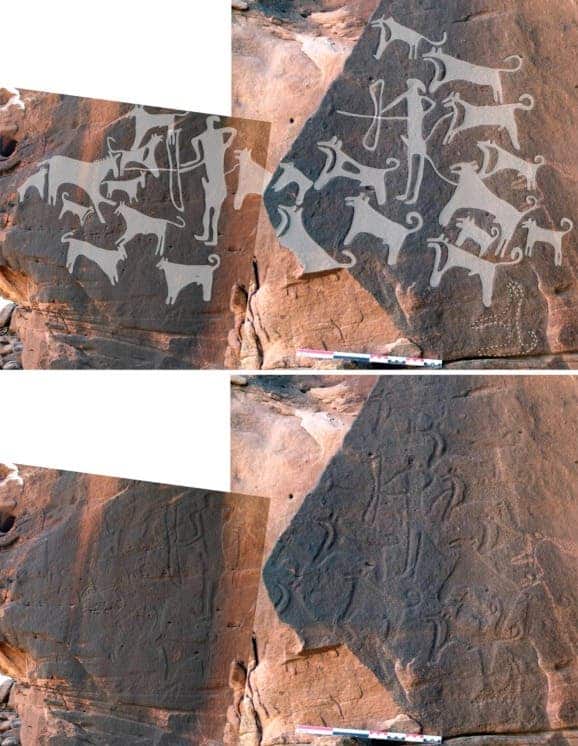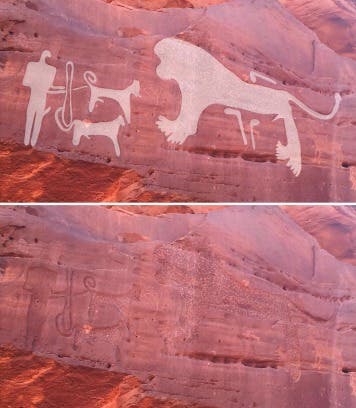Two ancient sites in Saudi Arabia have revealed an unexpected surprise, a new paper reports — the oldest known recording of dogs put on a leash. The 8,000-year-old images are etched into rock and depict humans and dogs working together in hunts before the widespread emergence of agriculture.
The carvings were discovered by Maria Guagnin, an archaeologist at the Max Planck Institute for the Science of Human History, at two rock-art sites in northwestern Saudi Arabia, Shuwaymis and Jubbah. The images, estimated to be around 8,000 years old, depict humans and dogs hunting side by side, and suggest that the two species were already ‘friends’ before farming took hold.

Image credits Guagnin, M. et al., 2017, Journal of Anthropological Archaeology.
The two sites “contain the best and oldest examples of Neolithic rock art,” Saudi-Archaeology claims, adding that the region used to be rich “with people, flora, and wildlife” in the past. Those people left behind thousands of panels of rock-art showcasing their lives, society, and hunts, which Guagnin was documenting when she stumbled upon the unusual scenes.
Overall, she counted 156 depictions of dogs at Shuwaymis and 193 at Jubbah. The animals resemble today’s Canaan breed in appearance, Guagnin adds, with pricked ears, curled tails, and short snouts. They’re most often depicted helping bow-wielding human hunters take down prey including lions, ibexes, gazelles, or horses. The animals are clearly distinct from the hyenas and wolves depicted in other panels, Guagnin and her co-authors write.


Image credits Guagnin, M. et al., 2017, Journal of Anthropological Archaeology.
From what we know so far, dogs were domesticated from an ancestor of today’s gray wolf between 40,000 and 15,000 years ago. There’s still a lot of unknowns (and thus, room for debate) about how and where this domestication process took place, and how early humans and dogs interacted and co-existed. The panels described by Guagnin’s team will help to guide these discussions in the future. The images haven’t been directly dated so far, but the team estimates they date back between 8,000 and 9,000 years ago, to the pre-Neolothic era, before farming took root in the region.
The most interesting find, however, was that some of the hunting dogs taking seem to be leashed. The art depicts these dogs as tethered to the waist of hunters, quite the smart hack when you need two free hands to shoot arrows. It hasn’t been established why these dogs were leashed, but the team speculates that they may have been young dogs still undergoing training, old ones that could be injured in the thick of the hunt, or scent dogs that were too valuable to risk.

“This suggests not only are some human populations controlling their hunting dogs by the Pre-Neolithic, but that some dogs may perform different hunting tasks than others,” the paper explains.
“Some may be used only to track prey scents, while others are used to corral and attack prey, protect human hunters, or help haul meat back to camp.”
The hunting scenes represent the earliest known evidence of dog leashes in the archaeological record worldwide, the study claims. Furthermore, they push back the presence of domesticated dogs on the Arabian Peninsula to much earlier than we’d believed. Previously, the oldest dog remains found on the whole peninsula hailed from the 4th millennium B.C. in today’s Yemen, some 2-3 thousand years younger that the estimated age of the Shuwaymis and Jubbah panels.
The paper, “Pre-Neolithic evidence for dog-assisted hunting strategies in Arabia” has been published in the Journal of Anthropological Archaeology.



